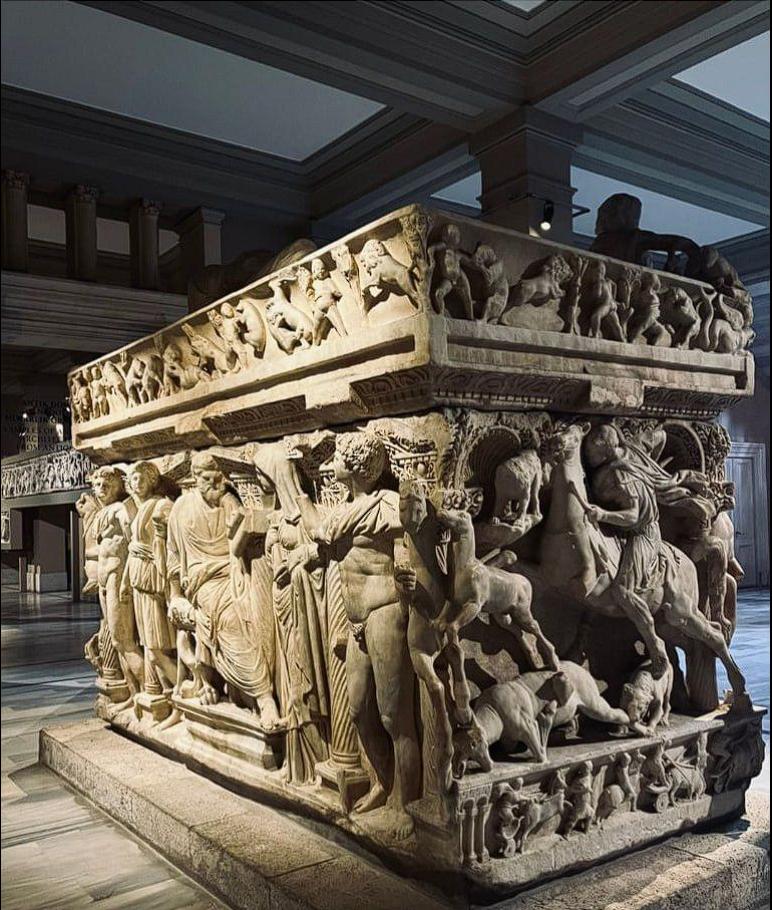“The Sidamara Sarcophagus, a colossal and exquisitely carved monument, stands as a testament to the grandeur of Roman artistry and the rich cultural tapestry of ancient Anatolia. Discovered in 1900 near the village of Ambar, the former Sidamara, this 32-tonne masterpiece, dating back to the 3rd century AD, offers a profound glimpse into the burial practices and artistic traditions of a bygone era. Its intricate reliefs and sheer scale, meticulously transported to Istanbul by Osman Hamdi Bey, make it a pivotal artifact in understanding the layered history of the region.”
A Monument Unveiled: The Discovery and Scale of Grandeur
- The Discovery in Ambar:
- The discovery of the Sidamara Sarcophagus in 1900 was a momentous archaeological find, revealing a monument of unparalleled size and artistic complexity. The location, near the ancient Sidamara, along a vital Roman road, hinted at its importance.
- This find was not merely an excavation but an unveiling of a lost chapter of Roman Anatolia, shedding light on the burial practices and artistic sophistication of the period.
- Sheer Size and Transport:
- The sarcophagus’s colossal size, weighing approximately 32 tonnes, presented a formidable challenge for its transport. The meticulous effort to move it to Istanbul, spearheaded by Osman Hamdi Bey, underscored its historical significance.
- This logistical feat, a testament to the dedication of early archaeologists, ensured that this masterpiece would be preserved for future generations, allowing for a deeper understanding of Roman artistry.
- Artistic Mastery:
- The intricate carvings that adorn all four sides of the sarcophagus demonstrate the extraordinary skill of Roman sculptors. The detailed reliefs, depicting human and animal figures, showcase a level of artistry that remains awe-inspiring.
- This artistic mastery not only highlights the technical prowess of the Roman artisans but also provides valuable insights into the cultural and symbolic narratives of the time.
Narratives in Stone: Decoding the Reliefs and Their Meanings
- The Deceased and His Wife:
- The lid of the sarcophagus portrays the deceased, likely a Roman nobleman, reclining beside his wife in a classical banquet pose. This depiction, common in funerary art, suggests a celebration of life and a continuation of earthly pleasures in the afterlife.
- This portrayal offers a glimpse into the social customs and beliefs of the Roman elite, highlighting the importance of familial bonds and the celebration of life after death.
- Philosophical Stance and Tender Gaze:
- One long side of the sarcophagus depicts the man seated in a philosophical or poetic stance, hinting at his intellect or social status. Next to him, his wife gazes toward him with a tender expression, portraying a sense of intimacy and affection.
- This scene provides a narrative depth to the monument, revealing the personal relationships and emotional connections that were valued in Roman society.
- Hunting Scene and Divine Figures:
- The opposite side of the sarcophagus presents a dynamic hunting scene, adding a narrative of valor and vitality. This scene, along with the figure of the goddess Artemis, believed to represent their daughter, portrays a multi-layered story of family, virtue, and heroism.
- These reliefs not only celebrate the deceased’s achievements but also reflect the cultural values and mythological beliefs of the Roman world.
A Cultural Bridge: Connecting Antiquity to Modern Appreciation
- Roman Sculpture Masterpiece:
- The Sidamara Sarcophagus stands as a masterpiece of Roman sculpture, showcasing the artistic excellence and cultural sophistication of the period. Its intricate carvings and narrative reliefs offer a window into the lives and beliefs of the Roman elite.
- This monument serves as a vital historical artifact, providing valuable insights into the artistic traditions and cultural practices of Roman Anatolia.
- Anatolian Heritage:
- The sarcophagus also serves as a cultural bridge, connecting the ancient world to modern appreciation of Anatolia’s layered past. It highlights the region’s rich history and its role as a crossroads of civilizations.
- This artifact underscores the importance of preserving and understanding Anatolia’s cultural heritage, ensuring that its rich history continues to inspire and educate future generations.
- Lasting Legacy:
- The Sidamara Sarcophagus, housed in the İstanbul Archaeology Museums, continues to captivate visitors and scholars alike. Its grandeur and artistic complexity serve as a reminder of the enduring legacy of Roman civilization in Anatolia.
- Its preservation and study contribute to our understanding of the ancient world, bridging the gap between antiquity and modernity.
Conclusion:
“The Sidamara Sarcophagus, a monument of Roman grandeur, stands as a profound testament to the artistic and cultural richness of ancient Anatolia. Its colossal size, intricate carvings, and narrative reliefs offer a unique glimpse into the lives and beliefs of the Roman elite. This masterpiece, carefully preserved and studied, serves as a cultural bridge, connecting the ancient world to modern appreciation of Anatolia’s layered past, ensuring that its legacy continues to resonate and inspire.”

CÁC TIN KHÁC
Mary Walton: The Forgotten Inventor Who Helped Clean Up America’s Cities
Tomb of Queen Nefertari in the Valley of the Queens, Egypt
Discover the Hypostyle Hall of the Temple of Hathor at Dendera
Venus de Losange: Unveiling the Mystery of a 20,000-Year-Old Paleolithic Icon